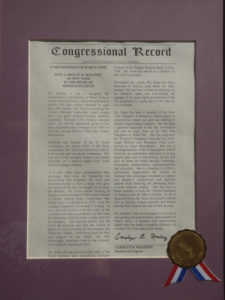May 3, 2021
by Ting Ting and Marcy Syms – Opinion Contributors
Last week President Biden released the American Families Plan, phase two of the administration’s infrastructure and economic recovery program. This second piece of legislation is expected to expand child care, paid leave and pre-K education and extend the strengthened child tax credit, while raising taxes on the wealthy. It has been widely touted as an historic investment in the U.S. economy that foregrounds gender equity and the needs of women, particularly working mothers.
The gender sensitivity that the Biden administration has brought to its plans to rebuild the U.S. economy is an excellent advance in public policy under any circumstance, but particularly coming in response to the economic devastation precipitated by the COVID epidemic. Unlike the “man-cession” of 2008, the “she-cession” of 2020 has disproportionately impacted less educated women of color in low-wage jobs, particularly those with children, according to a 2021 by the National Women’s Law Center.
But the history of U.S. social welfare and economic stimulus policies makes an even stronger case for a long-overdue gender-based focus from the administration, including the enactment of the Equal Rights Amendment in our Constitution to explicitly ban discrimination on the basis of sex. Put bluntly, the American Families Plan should be understood as one part of a broader effort to address historic gender inequality and correct the mistakes of the past — particularly the systematic, intentional and devastating sexism that has permeated national economic policy, including the foundational programs put in place during the New Deal.
The gender sensitivity that the Biden administration has brought toto its plans to rebuild the U.S. economy is an excellent advance in public policy under any circumstance, but particularly coming in response to the economic devastation precipitated by the COVID epidemic. Unlike the “man-cession” of 2008, the “she-cession” of 2020 has disproportionately impacted less educated women of color in low-wage jobs, particularly those with children, according to a 2021 study by the National Women’s Law Center.
Upon assuming the presidency, Frankling D. Roosevelt, like Joseph Biden, prioritized economic recovery in his first 100 days. Yet from top to bottom, FDR’s policies were designed with a white male worker in mind, reinforcing the ongoing durability of gendered divisions of labor, and prioritizing the idea of a family wage that enabled men to work in the labor market as “breadwinners,” so that their wives could do unpaid domestic work in the home, thus preventing them from entering the workforce and taking jobs that properly “belonged” to men. FDR put it best in an : The New Deal “undertakes the great task of furthering the security of the citizen and his family through social insurance.
Bias against women, especially women of color, permeated every one of the New Deal programs. To win the support of southern Democrats in Congress, Roosevelt’s unemployment inusrance regime exempted agricultural laborers, private domestic servants and government employees, among others — all labor sectors heavily staffed by white women, Black women, Black men and other people of color. Eligibility for unemployment payments required being available for full time work, thus excluding workers who did not have childcare and thus could only work part time. Black female domestic workers suffered unemployment disproportionately in the Depression. The exemption of domestic workers from unemployment insurance resulted in what became known as a “slave market” in places like the Bronx, where groups of Black women aged 17 to 70 lined up on the sidewalk for white women to drive up and offer them a day’s work.
In 1934, at the peak of its operations, the Civil Works Administration employed four million laborers in large-scale construction and public works projects, yet fewere than 300,000 of those workers were women. The Works Projects Administration, one of the largest public works projects ever undertaken, gave preferential consideration to male workers and prohibited the employment of “women, housewives, or mothers of dependent children,” who were needed at home to care for dependents, according to Mimi Abromovitz’s “Regulating the Lives of Women”, Black women received only 2.1 percent of WPA jobs and being told that they should “weather” fewer benefits because they were more accustomed to being disadvantaged than were white people.
To the extent that New Deal policies strengthened unions, this too was a gendered policy agenda, as most union members were men. As Abromovitz noted in the text, “Organized labor recommended denying jobs to women supported by a male breadwinner. The executive council of the AFL resolved that married women whose husbands have permanent positions should not be hired.” From the New Deal through today, in Democratic and Republican administrations alike, economic and social policy has advanced the interests of men over women. Nine in ten “traditional” infrastructure jobs have historically gone to men. The federal government’s long-term policy agenda favoring white male workers shows up in almost every economic indicator. The World Economic Forum ranks the US 87th in the world in its efforts to close the gender pay gap, behind France, North Macedonia and Montenegro. Women overall make men make, and these numbers are even worse for women of color : Black women make 63 cents, Native American women 60 cents, and Latinas 55 cents to every white male dollar. This inequity has long-lasting effects over a woman’s lifetime. According to the Government Accountability Office , women tend to face a larger retirement savings gap than men and they experience higher poverty rates at older ages.
The time has come to not only put an end to national economic policies that embrace what feminist historian Linda Gordon describes in the book: Pitied But Not Entitled, Single Mothers and the History of Welfare” ” as “a male vision,” but to repair historic disinvestment in women workers and especially women of color. This will require sex and race based set-asides in federal contracting, hiring women and people of color-owned businesses, including a#irmative hiring and employment benchmarks in funding programs, and of course, universal child care, parenting leave and protections for pregnant workers, among other measures. It will also require enacting a constitutional protection against gender bias, in the form of the Equal Rights Amendment, to provide an ironclad protection of women’s rights. The Biden administration’s infrastructure and economic recovery plans are an initial step towards removing and remedying the gender and racial bias baked into the U.S. social and economic policy. As a next step, Congress should act promptly to lift the deadline holding up the Equal Rights Amendment’s inclusion in the Constitution, thus securing sex equality, not as the gift or wisdom of one president only to be undone by the next, but as an explicit constitutional right that must be respected in every governmental law and policy.
Ting Ting Cheng is the director and Marcy Syms is a member of the advisory board of the ERA Project at Columbia Law School.




